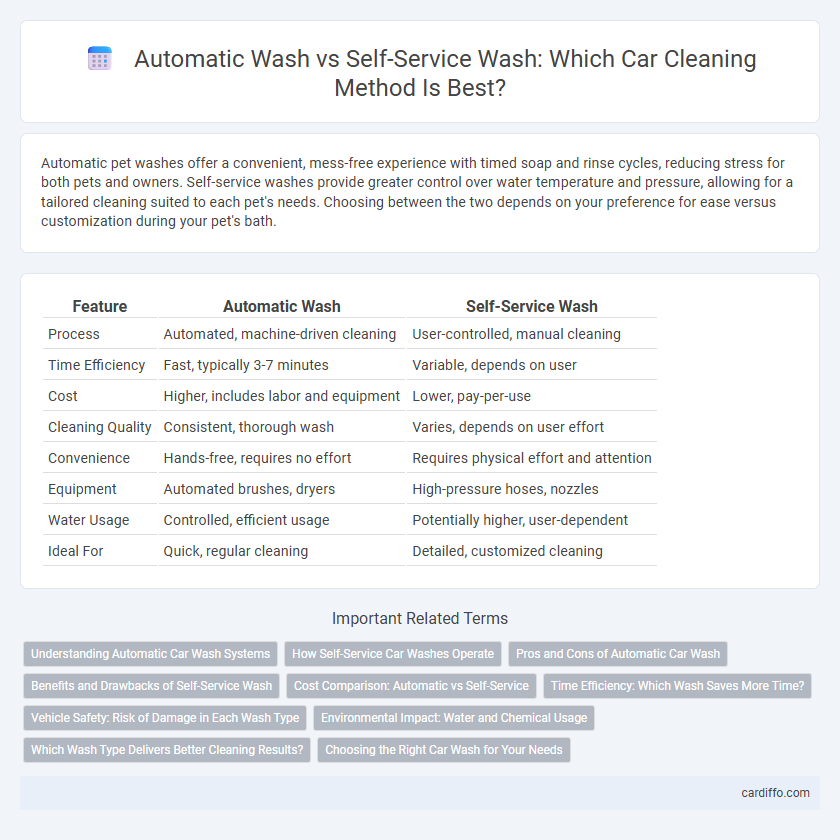Automatic pet washes offer a convenient, mess-free experience with timed soap and rinse cycles, reducing stress for both pets and owners. Self-service washes provide greater control over water temperature and pressure, allowing for a tailored cleaning suited to each pet's needs. Choosing between the two depends on your preference for ease versus customization during your pet's bath.
Table of Comparison
| Feature | Automatic Wash | Self-Service Wash |
|---|---|---|
| Process | Automated, machine-driven cleaning | User-controlled, manual cleaning |
| Time Efficiency | Fast, typically 3-7 minutes | Variable, depends on user |
| Cost | Higher, includes labor and equipment | Lower, pay-per-use |
| Cleaning Quality | Consistent, thorough wash | Varies, depends on user effort |
| Convenience | Hands-free, requires no effort | Requires physical effort and attention |
| Equipment | Automated brushes, dryers | High-pressure hoses, nozzles |
| Water Usage | Controlled, efficient usage | Potentially higher, user-dependent |
| Ideal For | Quick, regular cleaning | Detailed, customized cleaning |
Understanding Automatic Car Wash Systems
Automatic car wash systems utilize conveyor belts and high-pressure water jets to clean vehicles efficiently, reducing manual effort and time. These systems often incorporate advanced sensors, foam brushes, and drying mechanisms to ensure a thorough wash while minimizing paint damage. In comparison, self-service wash requires driver involvement but offers greater control over the cleaning process, often at a lower cost.
How Self-Service Car Washes Operate
Self-service car washes operate by providing customers with access to equipment such as high-pressure hoses, brushes, and soap dispensers, allowing them to wash their vehicles manually. Customers typically use coins, tokens, or electronic payment systems to select wash cycles and control the duration of the wash. These facilities prioritize user control and cost efficiency while requiring time and effort from the vehicle owner compared to automatic car washes.
Pros and Cons of Automatic Car Wash
Automatic car washes offer fast and convenient cleaning with consistent results, using advanced brushes and high-pressure water jets to remove dirt efficiently. They reduce the physical effort required and minimize water usage compared to manual washing methods. However, automatic systems may cause minor scratches on delicate paint surfaces and are generally less customizable than self-service wash options.
Benefits and Drawbacks of Self-Service Wash
Self-service wash offers cost savings and greater control over the cleaning process, allowing users to target specific areas of their vehicle with customized pressure and soap application. However, it requires more physical effort and time compared to automatic wash systems, which provide convenience and consistent results through automated brushes and rinses. Potential drawbacks of self-service washing include inconsistent cleaning quality and higher water usage, which may impact overall efficiency.
Cost Comparison: Automatic vs Self-Service
Automatic car washes typically cost between $7 and $15 per wash, offering convenience and a thorough clean with minimal effort. Self-service washes, priced around $3 to $6, provide a budget-friendly option allowing users to customize their wash but require more time and effort. The cost difference reflects the balance between convenience and manual labor in these two wash types.
Time Efficiency: Which Wash Saves More Time?
Automatic wash systems typically save more time compared to self-service washes by completing the entire cleaning cycle in as little as 5 to 7 minutes, whereas self-service washes often require 15 to 20 minutes depending on user speed and thoroughness. High-pressure rinse and drying stages in automatic washes are optimized for speed and consistency, reducing overall wait times. Vehicles that frequently visit automatic washes benefit from consistent, expedited service that maximizes time efficiency.
Vehicle Safety: Risk of Damage in Each Wash Type
Automatic washes use controlled machinery designed to minimize scratches and dents, but older or poorly maintained systems can sometimes cause paint damage or sensor issues. Self-service washes give vehicle owners direct control, reducing the risk of machine-related damage but increasing the chance of user error such as harsh scrubbing or missed spots that may lead to corrosion. Assessing the specific equipment quality and user experience is essential for minimizing the risk of vehicle damage in both wash types.
Environmental Impact: Water and Chemical Usage
Automatic wash systems typically use advanced sensors and calibrated nozzles to minimize water and chemical consumption, resulting in lower environmental impact compared to traditional self-service washes. Self-service wash stations often lead to overuse of water and detergents due to manual operation, increasing runoff contamination and resource waste. Studies show automatic washes can reduce water usage by up to 50% and use biodegradable chemicals that degrade more quickly, promoting eco-friendly vehicle cleaning.
Which Wash Type Delivers Better Cleaning Results?
Automatic washes consistently deliver superior cleaning results due to advanced high-pressure jets and multi-stage detergents that penetrate grime more effectively than manual self-service methods. Self-service washes depend heavily on user technique and often lack targeted cleaning zones critical for removing stubborn dirt and brake dust. Studies reveal automatic wash systems reduce contaminants by up to 30% more, ensuring a deeper, more uniform clean.
Choosing the Right Car Wash for Your Needs
Automatic wash systems offer convenience and speed by using advanced sensors and brushes to clean your vehicle thoroughly with minimal effort, ideal for busy schedules. Self-service washes provide greater control and customization, allowing users to target specific areas and use preferred cleaning products, often at a lower cost. Selecting the right car wash depends on your priorities for convenience, budget, and the level of attention your vehicle requires.
Automatic Wash vs Self-Service Wash Infographic

 cardiffo.com
cardiffo.com